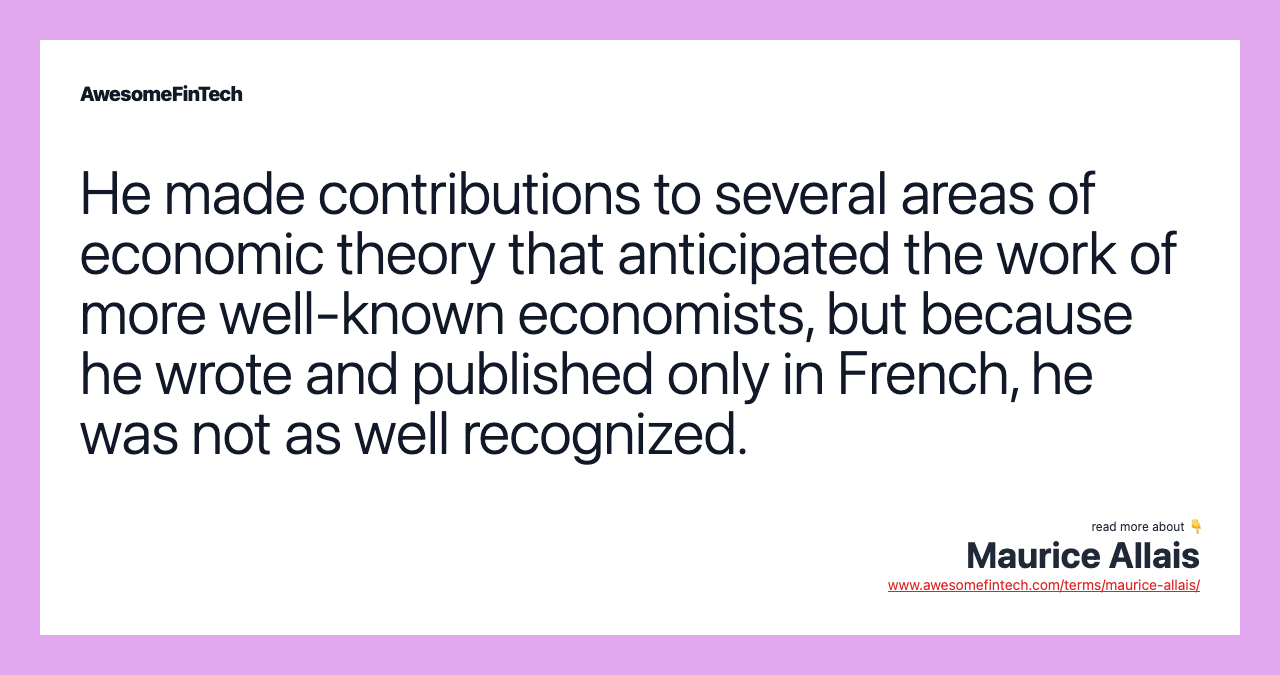Maurice Allais
Maurice Allais (1911–2010) was a prolific neoclassical economist who won the 1988 Nobel Memorial Prize in Economic Sciences for his research on market equilibrium and efficiency. He also won a prestigious French award, the Gold Medal of the National Center for Scientific Research; developed methods that state-owned monopolies, common in France, could use to set prices; and discovered and resolved what became known as the Allais paradox, which explains people's risk management behavior. Maurice Allais was a neoclassical economist who won the Nobel Prize for his work in general equilibrium theory in 1988. Allais' areas of economic research included general equilibrium theory, capital theory, decision theory, monetary theory, and probability theory. This was the primary topic of his first book, _A la Recherche d'une Discipline Economique. L 'Economic Pure_, which focused on the proof of his two equivalence theorems: 1) that any state of equilibrium in a market economy is also the state of maximum efficiency, and 2) that any state of maximum efficiency is also the state of equilibrium. Allais's second book, _Economie et Intérêt_, Allais combined his interest in the physics of oscillations with his observations on economic decision-making under uncertainty and economic cycles to later argue that virtually all of the random variation in physical, biological, psychological, and economic time series results from the resonance of vibrations that permeate space throughout the universe.

More in Economy
Who Was Maurice Allais?
Maurice Allais (1911–2010) was a prolific neoclassical economist who won the 1988 Nobel Memorial Prize in Economic Sciences for his research on market equilibrium and efficiency.
He also won a prestigious French award, the Gold Medal of the National Center for Scientific Research; developed methods that state-owned monopolies, common in France, could use to set prices; and discovered and resolved what became known as the Allais paradox, which explains people's risk management behavior.



Understanding Maurice Allais
Allais was born in Paris, where his family owned a small cheese shop. His father died in a German prisoner-of-war camp during World War I, and his mother raised him in near-poverty. Allais loved math and science, excelling in school and eventually studying mining.
Before the outbreak of World War II, he managed French national mining interests, then became a professor of economics at the École Nationale Supérieure des Mines de Paris while also pursuing his own research in experimental physics, particularly the relationship between gravity and pendulum movements.
But a trip to New York during the Great Depression inspired him to become an economist so he might understand what triggered such devastating financial calamities. Throughout his career, Allais stood astride the boundary of socialism and free-market economics.
He favored achieving economic efficiency regardless of whether the means would be markets or central planning and sought a synthesis between the two. Contrary to many of his contemporaries, Allais staunchly opposed globalization and was deeply skeptical of European integration, believing that protecting local markets helped to alleviate poverty.
Contributions
Allais worked in relative obscurity for decades, primarily because he resisted writing in English, which is the preferred language of economists internationally. In the 1970s, before Allais was widely known outside France, the American economist Paul Samuelson won a Nobel Prize for similar research into market theories. Samuelson later said that had Allais' earlier works been known in English, "a generation of economic theory would have taken a different course."
Allais' areas of economic research included general equilibrium theory, capital theory, decision theory, monetary theory, and probability theory.
General Equilibrium
Allais' work in microeconomic theory and general equilibrium paralleled or anticipated many of the theories developed by neoclassical and Neo-Keynesian economists in the mid-20th century.
This was the primary topic of his first book, A la Recherche d'une Discipline Economique. L 'Economic Pure, which focused on the proof of his two equivalence theorems: 1) that any state of equilibrium in a market economy is also the state of maximum efficiency, and 2) that any state of maximum efficiency is also the state of equilibrium.
Capital Theory
Allais's second book, Economie et Intérêt, focused on capital theory and trade-offs between present and future productivity. Also noteworthy was his so-called golden rule of economic growth: namely that real income grows most efficiently when interest rates and growth rates are equal.
Decision Theory
Allais sought to extend his general equilibrium analysis to economic decision-making under conditions of risk and uncertainty. His research into risk management led to his famous paradox: "The less the risk is, the more the speculators flee."
Monetary Theory
Beginning in the 1950s, Allais developed a theory of monetary dynamics based on the supply of money and the demand to hold money. This theory relied on his previous work on intergenerational and psychological aspects of capital theory and decision theory to explain monetary demand. He argued that his theory explained the historical pattern of economic cycles.
Probability Theory
Allais combined his interest in the physics of oscillations with his observations on economic decision-making under uncertainty and economic cycles to later argue that virtually all of the random variation in physical, biological, psychological, and economic time series results from the resonance of vibrations that permeate space throughout the universe.
He believed that these almost perfectly periodic vibrations created a deterministic structure to the universe that only appears to be random because it consists of many overlapping vibrations of different frequencies and amplitude.
Related terms:
Who Is A. Michael Spence? What Is His Market Signaling Theory?
A. Michael Spence is an American economist who won the 2001 Nobel Prize for his theory of market signaling. read more
Economics : Overview, Types, & Indicators
Economics is a branch of social science focused on the production, distribution, and consumption of goods and services. read more
Inflation
Inflation is a decrease in the purchasing power of money, reflected in a general increase in the prices of goods and services in an economy. read more
Kenneth Arrow Biography
Kenneth Arrow was an American economist who won the Nobel Prize in Economics in 1972 for his work in general equilibrium analysis and welfare economics. read more
Paul Samuelson
Paul Samuelson was an economics professor at MIT who received the Nobel Prize in 1970 for his contributions to the field. read more
Risk Management in Finance
In the financial world, risk management is the process of identification, analysis, and acceptance or mitigation of uncertainty in investment decisions. read more
Who Is Robert E. Lucas Jr.? What Is His Economic Theory?
Robert E. Lucas Jr. is a New Classical economist who won the 1995 Nobel Memorial Prize in Economic Sciences for his research on rational expectations. read more
Robert M. Solow
Robert M. Solow is an American economist who spent his career at MIT and received the Nobel Prize in Economics in 1987. read more
Wassily Leontief
Wassily Leontief was a Russian-American economist and professor who won the Nobel Prize in Economics for his research on input-output analysis. read more